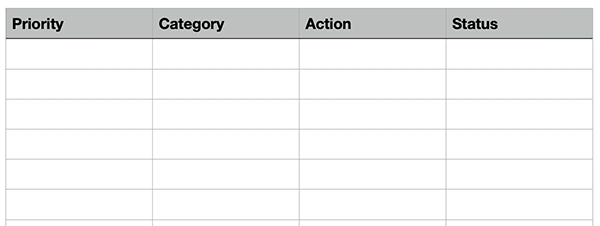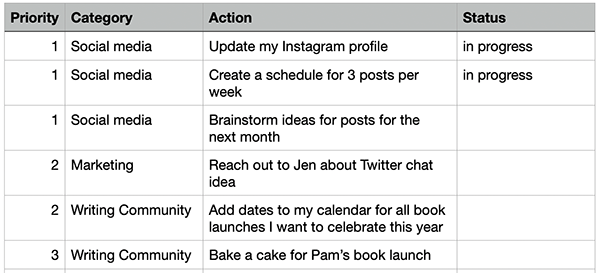A few weeks ago I talked about a creative reset I have been working on. The last quarter of every year, I spend three months on a creative and strategic reset. The idea is to review my daily work and compare it to what I want to be creating and sharing.
Today I would like to share more about that process so that you can use it to focus your efforts with how you grow your author platform and focus your marketing efforts. Below I’ll share the template for my Creative Action Plan. I’ll also share my own intentions for this year.
Last year taught me that intentions can easily be thwarted. But that doesn’t mean we don’t make them. Because setting an intention allows us to adjust when things don’t go as expected. For your creative goals, you never know what will “go viral” and you can’t 100% plan for a book launch that meets your expectations.
But you can prepare, and to me, that is the necessary groundwork for developing a strategy to create more and ensure your work connects with people in a meaningful way.
A SIMPLE LIST OF ACTIONS
In previous years, this process is one where I create a long document filled with ideas. But this year I did it differently. I was concerned of becoming overwhelmed by too many big ideas that would be complex to execute. So instead I created a simple list in a spreadsheet. The purpose of using it is to focus on small meaningful actions.
The Creative Action Plan spreadsheet contains the following columns:
- Priority: Because this list of actions is likely to get long, the priority column is where I can move certain tasks to an immediate priority to work on it now, and then assign other tasks as those I will get to in a few weeks or even months.
- Category: I group like items together by categorizing them. So for your own goals, perhaps you have categories of: social media, outreach, book launch, publicity, etc. I also sometimes color-code the categories so I can easily see similar tasks at a glance.
- Action: This is the primary focus of the spreadsheet, the list of specific actions you want to take. Each row should have a clear action you can take. So you wouldn’t have a row of “redesign website,” instead it would be one step to get there that you can do more easily. E.G.: get photo for homepage; write About page; pick website theme; etc.
- Status: For the tasks I am working on, I keep track of how progress is going, and mark them as done when complete.
It looks like this:

And here is an example of what it could look like when filled out:

As I work on each task, I sometimes need to add additional tabs to the spreadsheet. So let’s say one of your tasks is to become more involved in the Bookstagrammer community (those who chat about books on Instagram), then perhaps you create a new tab that lists out all of the Bookstagrammers you find.
Or if you want to focus on celebrating the book launches for other authors in your genre, you would create another tab with their names and book launch dates.
The goal with the entire spreadsheet is to write as little as possible, keeping it focused on small actions. Often that has me breaking down bigger ideas into tiny actions. At first I may write out a task like “Update Twitter profile” and then realize that is really 3 tasks: get a new profile image, rewrite my 1-line bio, and then determine if I can create a more helpful link than just my homepage.
I find the smaller tasks mean I can make progress more quickly, partly because I am understanding the goal in a more nuanced way, but also because it allows me to take action without feeling overwhelmed.
You can download the Creative Action Plan template here.
QUICK DAILY TASKS
In my calendar, I set a recurring daily task every morning to work on these creative intentions. This means that every day, I have to take some action on one of these tasks. That action is sometimes big — I email 5 people or work on a larger strategy. But oftentimes, it is ridiculously small. I send one quick email, or I fix one tiny thing.
The whole idea is to integrate this kind of work into my daily life. As I mentioned above, that removes the sense of pressure and overwhelm that often stymies projects like these. I have found that fear is often what holds people back from pursuing their creative goals more seriously. Everything about this process is meant to be so simple and small that it reduces the fear that keeps us from taking action.
I put the Creative Action Plan in a place I will see it all the time on my computer. For instance: clear your computer desktop of all other files (just throw them in a folder titled “everything else!”) and then have the Creative Action Plan alone on your desktop. Maybe change the name of it so it stands out even more: “____CrEaTiVeAcTiOnPlAn____”
If you are using a paper planner, you can do the same thing: clear your desk of all else so the action plan is all that you see in the morning.
This is how I have been setting creative intentions this year, including platform and marketing. I am challenging myself to double down on creating and connecting. I am focusing on these things:
- Honing the work I love doing.
- Creating more fun and useful experiences for writers and creators.
- Focusing on the depth of connections – how can I have more long conversations and help more people truly make progress with their creative goals.
This will all happen within the work I already do: consulting with writers, interviewing people on my podcast, in my newsletter, and my social media channels. Stay tuned!
As you enter the new year, I would love to know what are your creative intentions for this year? Reply back and let me know.
Thanks!
-Dan
